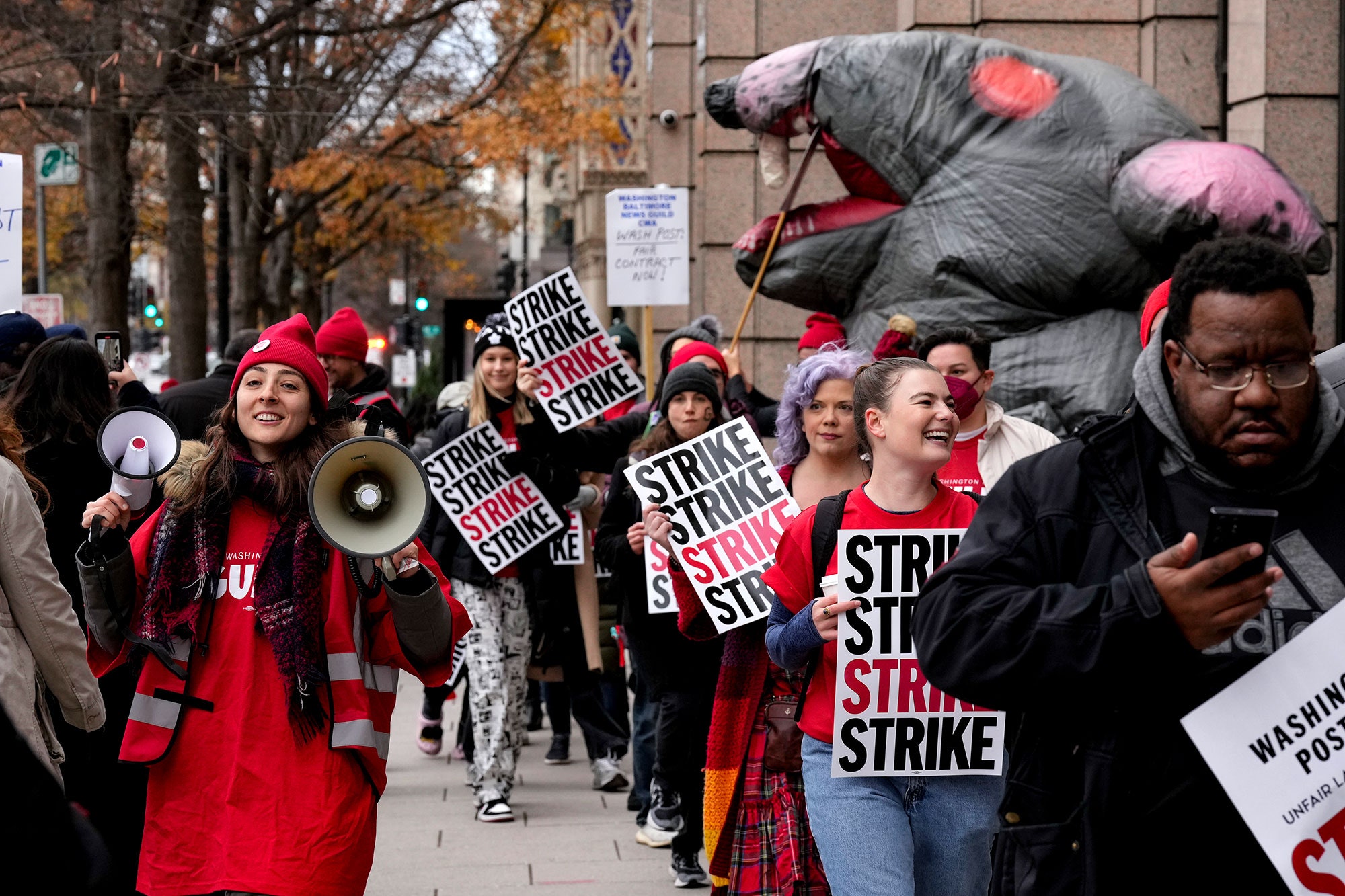"Le persone sono disgustate": perché il personale del Washington Post si è ritirato | Vanity Fair

Di Charlotte Klein
Più di 700 dipendenti del Washington Post hanno abbandonato il lavoro giovedì, uno sciopero storico per protestare contro il blocco delle trattative contrattuali del sindacato - e, per alcuni, per esporre reclami più ampi sulle modalità di direzione. "C'è semplicemente molta angoscia per molte cose", mi ha detto un dipendente del Post.
Lo sciopero di 24 ore - qualcosa che, secondo i leader del Post Guild, non accadeva nel giornale dagli anni '70 - è iniziato a mezzanotte di giovedì. Lo sciopero è "in protesta contro gli sforzi dell'azienda di negoziare in malafede" e "concludere unilateralmente le trattative sul contratto e con i riscatti annunciati all'inizio di quest'anno", ha detto la reporter del clima del Post Sarah Kaplan. "Questa è una dichiarazione di centinaia di dipendenti del Washington Post che dicono che l'azienda deve lavorare con noi in modo equo" e "rispettare il fatto che questa organizzazione giornalistica non funziona senza di noi". Un presidio è stato eretto all'esterno della sede del giornale a Washington, dove il personale partecipante, organizzato in turni, ha iniziato la dimostrazione di mattina presto.
Questo contenuto può essere visualizzato anche sul sito da cui proviene.
"Fatto: Jeff Bezos ha comprato il nostro giornale un decennio fa", ha detto Katie Mettler, reporter di Metro e da tempo copresidente del Post Guild, durante un raduno pomeridiano al presidio. "Fatto: L'ha comprato sperando che diventassimo una società in pareggio o redditizia. Fatto: Siamo diventati redditizi. Abbiamo fatto il nostro lavoro. Abbiamo raggiunto i nostri obiettivi. E poi il nostro ex editore Fred Ryan" - provocando fischi dalla folla - "ha dissipato i nostri profitti, e adesso siamo qui, chiesti di prendere responsabilità per gli errori dell'azienda. E non penso che sia giusto - non penso che dovremmo sopportare il peso della loro cattiva gestione". Mettler ha continuato: "Fred Ryan aveva un solo capo ed era Jeff Bezos, quindi penso che sia ragionevole che lo consideriamo responsabile... lui ha il potere di dare istruzioni alle persone che attualmente dirigono questa azienda... di tornare al tavolo delle trattative".
Il Post Guild, il sindacato dei dipendenti, sta negoziando con l'azienda da 18 mesi. In quel periodo, Ryan se n'è andato, Bezos ha nominato l'ex dirigente di Microsoft e fidata di lunga data Patty Stonesifer come amministratrice delegata ad interim, e Stonesifer ha nominato Will Lewis, ex amministratore delegato del Wall Street Journal, come prossimo editore del giornale. Nello stesso periodo sono emerse anche le difficoltà finanziarie del Post, con il New York Times che ha riportato che il giornale avrebbe perso 100 milioni di dollari quest'anno e, a metà ottobre, il Post ha offerto riscatti a 240 dipendenti tra il suo staff.
Tuttavia, la settimana scorsa, Stonesifer ha detto al personale che potrebbero essere necessari "licenziamenti involontari" per raggiungere l'obiettivo di 240 accettazioni nel pacchetto di separazione, che fino a quel punto solo 120 dipendenti avevano accettato. L'azienda inizialmente ha posto limiti a ogni team a cui ha offerto riscatti, significando che avrebbero accettato riscatti solo per un certo numero di squadre fino a quel limite, ma Stonesifer nella sua nota della settimana scorsa ha detto che "considereremmo di aumentare i limiti dove possiamo minimizzare l'impatto sulla nostra missione e il nostro prodotto". Nel frattempo, il personale ha cercato chiarezza sulla strategia a lungo termine, come avevo precedentemente riferito, sia dal punto di vista aziendale che editoriale. "La gente è disgustata dalle azioni dell'azienda. Sia per quanto riguarda i finti riscatti volontari, che in realtà sono licenziamenti, sia per la mancanza di progressi su un contratto ragionevole", ha detto il dipendente del Post.
With hundreds of staffers pledging support for the walkout earlier this week, a second Post staffer said “it’s going to be noticeable,” but questioned “whether it’s going to be effective.” In some cases, entire departments, such as the Metro and investigative teams, committed to walking out, Post reporter Marissa Lang said, as did “colleagues on the commercial side, and in the print plant,” who walked off their jobs in the early hours of Thursday morning. “A walkout of 750 people touches every part of the Washington Post organization,” said Lang. Earlier this week, Post Guild released an open letter asking readers to “respect our walkout by not crossing the picket line,” meaning “do not engage with any Washington Post content.” If you did read the Post on Thursday, though, you may have noticed some stories—like one about a new crime center in DC to the paper’s own coverage of its labor protest —had a general byline: “By Washington Post Staff.” Either reporters had their names stripped off stories, or the generically bylined pieces were written by editors.
Staffers I spoke to had mixed feelings about how much this action will really do. “I think people are genuinely impressed by how this young contention of leaders has revived the union, and doubled its membership,” said a third Post staffer. But “a lot of the same people are disappointed to see that they’re acting out in this way that doesn't seem to be connected to any real prospect of progress on pay of jobs.” I’m told that there was internal second-guessing on Thursday among reporters who’d agreed to walk out but were now wondering, among other things, what would come next. Some high-profile staffers signed onto the strike out of fear of being publicly called out if they didn’t participate, according to a Post staffer. A piece in Semafor did just that to two top New York Times reporters, Peter Baker and Michael Shear, last year when the two opted out of the Gray Lady union’s walkout—an article, the Post staffer said, that had been circulating in recent days.
Asked about the Guild’s plan following the strike, Lang said they would “extend another one-day invitation to the company to sit down with us and meaningfully bargain over the terms of our contract. If they refuse and continue to engage in some of the behavior we’ve seen, we’re prepared to continue to pressure them,” she said.
The Post Guild’s decision to walk off the job amid lagging contract negotiations comes nearly one year to the day that the Times’s unionized staffers rallied outside the newspaper’s headquarters in their own historic act of protest. Several months later, the Times’s bitter labor fight came to an end as the staff union and company agreed to a contract. In August, Axios reported that members of the Times union briefed staffers from the Post union as the Post considered a walkout of its own.
There are distinctions between the staff appeals at the two papers. Part of the Times union’s rallying call last year was tied to the company having increased compensation for some top officers and increased its dividend payout to shareholders. The Post’s walkout, on the other hand, comes as the company has admitted it’s been operating on faulty financial projections and is buying out—or, potentially, laying off—about 10% of its workforce. While one Post staffer acknowledged its New York–based rival is on firmer financial footing these days, they also pointed out the Times is “not owned by the second richest guy in the world.”




